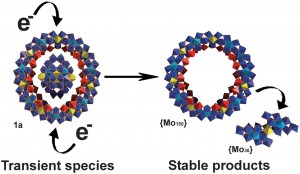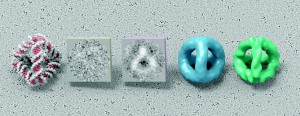It’s fifty years since Richard Feynman delivered his famous lecture “There’s Plenty of Room at the Bottom”, and this has been the signal for a number of articles reflecting on its significance. This lecture has achieved mythic importance in discussions of nanotechnology; to many, it is nothing less than the foundation of the field. This myth has been critically examined by Chris Tuomey (see this earlier post), who finds that the significance of the lecture is something that’s been attached retrospectively, rather than being apparent as serious efforts in nanotechnology got underway.
There’s another narrative, though, that is popular with followers of Eric Drexler. According to this story, Feynman laid out in his lecture a coherent vision of a radical new technology; Drexler popularised this vision and gave it the name “nanotechnology”. Then, inspired by Drexler’s vision, the US government launched the National Nanotechnology Initiative. This was then hijacked by chemists and materials scientists, whose work had nothing to do with the radical vision. In this way, funding which had been obtained on the basis of the expansive promises of “molecular manufacturing”, the Feynman vision as popularized by Drexler, has been used to research useful but essentially mundane products like stain resistant trousers and germicidal washing machines. To add insult to injury, the material scientists who had so successfully hijacked the funds then went on to belittle and ridicule Drexler and his theories. A recent article in the Wall Street Journal – “Feynman and the Futurists” – by Adam Keiper, is written from this standpoint, in a piece that Drexler himself has expressed satisfaction with on his own blog. I think this account is misleading at almost every point; the reality is both more complex and more interesting.
To begin with, Feynman’s lecture didn’t present a coherent vision at all; instead it was an imaginative but disparate set of ideas linked only by the idea of control on a small scale. I discussed this in my article in the December issue of Nature Nanotechnology – Feynman’s unfinished business (subscription required), and for more details see this series of earlier posts on Soft Machines (Re-reading Feynman Part 1, Part 2, Part 3).
Of the ideas dealt with in “Plenty of Room”, some have already come to pass and have indeed proved economically and societally transformative. These include the idea of writing on very small scales, which underlies modern IT, and the idea of making layered materials with precisely controlled layer thicknesses on the atomic scale, which was realised in techniques like molecular beam epitaxy and CVD, whose results you see every time you use a white light emitting diode or a solid state laser of the kind your DVD contains. I think there were two ideas in the lecture that did contribute to the vision popularized by Drexler – the idea of “a billion tiny factories, models of each other, which are manufacturing simultaneously, drilling holes, stamping parts, and so on”, and, linked to this, the idea of doing chemical synthesis by physical processes. The latter idea has been realised at proof of principle level by the idea of doing chemical reactions using a scanning tunnelling microscope; there’s been a lot of work in this direction since Don Eigler’s demonstration of STM control of single atoms, no doubt some of it funded by the much-maligned NNI, but so far I think it’s fair to say this approach has turned out so far to be more technically difficult and less useful (on foreseeable timescales) than people anticipated.
Strangely, the second part of the fable, which talks about Drexler popularising the Feynman vision, I think actually underestimates the originality of Drexler’s own contribution. The arguments that Drexler made in support of his radical vision of nanotechnology drew extensively on biology, an area that Feynman had touched on only very superficially. What’s striking if one re-reads Drexler’s original PNAS article and indeed Engines of Creation is how biologically inspired the vision is – the models he looks to are the protein and nucleic acid based machines of cell biology, like the ribosome. In Drexler’s writing now (see, for example, this recent entry on his blog), this biological inspiration is very much to the fore; he’s looking to the DNA-based nanotechnology of Ned Seeman, Paul Rothemund and others as the exemplar of the way forward to fully functional, atomic scale machines and devices. This work is building on the self-assembly paradigm that has been such a big part of academic work in nanotechnology around the world.
There’s an important missing link between the biological inspiration of ribosomes and molecular motors and the vision of “tiny factories”- the scaled down mechanical engineering familiar from the simulations of atom-based cogs and gears from Drexler and his followers. What wasn’t fully recognised until after Drexler’s original work, was that the fundamental operating principles of biological machines are quite different from the rules that govern macroscopic machines, simply because the way physics works in water at the nanoscale is quite different to the way it works in our familiar macroworld. I’ve argued at length on this blog, in my book “Soft Machines”, and elsewhere (see, for example, “Right and Wrong Lessons from Biology”) that this means the lessons one should draw from biological machines should be rather different to the ones Drexler originally drew.
There is one final point that’s worth making. From the perspective of Washington-based writers like Kepier, one can understand that there is a focus on the interactions between academic scientists and business people in the USA, Drexler and his followers, and the machinations of the US Congress. But, from the point of view of the wider world, this is a rather parochial perspective. I’d estimate that somewhere between a quarter and a third of the nanotechnology in the world is being done in the USA. Perhaps for the first time in recent years a major new technology is largely being developed outside the USA, in Europe to some extent, but with an unprecedented leading role being taken in places like China, Korea and Japan. In these places the “nanotech schism” that seems so important in the USA simply isn’t relevant; people are just pressing on to where the technology leads them.

